Strength of Superelastic NiTi Velcro-Like Fasteners
Abstract
1. Introduction
2. Materials and Methods
2.1. NiTi Wires and Their Properties
2.2. NiTi Velcro-Type Samples
2.3. Force Measurement
2.4. Method to Estimate the Number of Interlocked Hooks
- (i)
- During approaching and the fastener engagement, the substrate planes remain parallel. So do the arrays’ edges (no mutual rotation of the arrays).
- (ii)
- When drawing the two fastener’s parts closer to each other, no lateral movements are made.
- Choosing hook density related to parameter r and working with fixed parameters win, and wout.
- Generating random values of hook’s head angles, ψij, ψi’j’ and small lateral shifts, px, py.
- Calculating the coordinates of points Asij, Afij, Bsi’j’ and Bfi’j’ according to the equations in Figure 6c.
- Finding all hook connections between array 1 and array 2 according to Equations (1)–(3) and forming the equivalent undirected graph.
- Finding all connected components (using the DFS algorithm), their types and their numbers (e.g., fifty 1 + 1 connections, ten 1 + 2 connections, two 3 + 1 connections, etc., where the term “m + n connections” means that m hooks from array 1 are interconnected with n hooks from array 2.)
- Repeating steps 2–5 at least ten times.
- Calculating the mean value and standard deviation for each type of connection.
3. Results and Discussion
4. Conclusions
Author Contributions
Funding
Institutional Review Board Statement
Informed Consent Statement
Data Availability Statement
Acknowledgments
Conflicts of Interest
References
- Keshavarzi, S.; Mescheder, U.; Reinecke, H. Room temperature Si–Si direct bonding technique using Velcro-like surfaces. J. Microelectromech. Syst. 2016, 25, 371–379. [Google Scholar] [CrossRef]
- Sharma, P.; Saggiomo, V.; van der Doef, V.; Kamperman, M.; Dijksman, J.A. Hooked on mushrooms: Preparation and mechanics of a bioinspired soft probabilistic fastener. Biointerphases 2021, 16, 011002. [Google Scholar] [CrossRef] [PubMed]
- Lindsie, J.; Lentink, D. Design Principles and Function of Mechanical Fasteners in Nature and Technology. Appl. Mech. Rev. 2020, 72, 050802. [Google Scholar]
- Van Humbeeck, J.; Stalmans, R. Characteristics of shape memory alloys. In Shape Memory Materials, 1st ed.; Otsuka, K., Wayman, C.M., Eds.; Cambridge University Press: Cambridge, UK, 1998; pp. 149–183. [Google Scholar]
- Leu, C.C.; Vokoun, D.; Hu, C.T. Two-way shape memory effect of TiNi alloys induced by hydrogenation. Metall. Mater. Trans. A 2002, 33, 17–23. [Google Scholar] [CrossRef]
- Chang, C.Y.; Vokoun, D.; Hu, C.T. Two-way shape memory effect of NiTi alloy induced by constraint aging treatment at room temperature. Metall. Mater. Trans. A 2001, 32, 1629–1634. [Google Scholar] [CrossRef]
- Schuster, A. Werkstoffkundliche und fertigungstechnische Untersuchungen eines Klettverschlusses mit Verwebten Formgedächtnis-Drähten. Ph.D. Thesis, Der Fakultat fur Maschinenbau der Ruhr-Universitat Bochum, Bochum, Germany, 2001. [Google Scholar]
- Schuster, A.; Voggenreiter, H.F.; Dunand, D.C.; Eggeler, G. A new type of intrinsic two-way shape memory. J. Phys. IV 2003, 112, 1177–1180. [Google Scholar]
- Vokoun, D.; Sedlak, P.; Frost, M.; Pilch, J.; Majtas, D.; Sittner, P. Velcro-like fasteners based on NiTi micro-hook arrays. Smart Mater. Struct 2011, 20, 085027. [Google Scholar] [CrossRef]
- Vokoun, D.; Majtas, D.; Frost, M.; Sedlak, P.; Sittner, P. Shape memory hooks employed in fasteners. J. Mater. Eng Perform. 2009, 18, 706–710. [Google Scholar] [CrossRef]
- Heller, L.; Šittner, P.; Sedlák, P.; Seiner, H.; Tyc, O.; Kadeřávek, L.; Sedmák, P.; Vronka, M. Beyond the strain recoverability of martensitic transformation in NiTi. Int. J. Plast. 2019, 116, 232–264. [Google Scholar] [CrossRef]
- Pugno, N.M. Velcro® nonlinear mechanics. Appl. Phys. Lett. 2007, 90, 121918. [Google Scholar] [CrossRef]
- Gorb, S.N.; Popov, V.L. Probabilistic fasteners with parabolic elements: Biological system, artificial model and theoretical considerations. Philos. Trans. R. Soc. A 2002, 360, 211–225. [Google Scholar] [CrossRef] [PubMed]
- Chen, Q.; Gorb, S.N.; Gorb, E.; Pugno, N. Mechanics of plant fruit hooks. J. R Soc. Interface 2013, 10, 20120913. [Google Scholar] [CrossRef] [PubMed]
- Bauer, G.; Klein, M.C.; Gorb, S.N.; Speck, T.; Voigt, D.; Gallenmüller, F. Always on the bright side: The climbing mechanism of Galium aparine. Proc. R. Soc. B: Biol. Sci. 2011, 278, 2233–2239. [Google Scholar] [CrossRef] [PubMed]
- Zhang, J.; Wang, J.; Yuan, Z. Experimental and Numerical Investigation on the Mechanical Behaviors of the Velcro® and Dual-Lock Fasteners. J. Harbin Inst. Technol. (New Series) 2019, 2, 61–70. [Google Scholar]
- Mariani, L.M.; Esposito, C.M.; Angiolillo, P.J. Observations of stick-slip friction in Velcro®. Tribol. Lett. 2014, 56, 189–196. [Google Scholar] [CrossRef]
- Heller, L.; Vokoun, D.; Šittner, P.; Finckh, H. 3D flexible NiTi-braided elastomer composites for smart structure applications. Smart Mater. Struct. 2012, 21, 045016. [Google Scholar] [CrossRef]
- Tarjan, R. Depth-first search and linear graph algorithms. SIAM J. Comput. 1972, 1, 146–160. [Google Scholar] [CrossRef]
- Turner, R. C#: The Ultimate Beginner’s Guide to Learn C# Programming Step by Step; N.B.L Publishing Published: San Francisco, CA, USA, 2019. [Google Scholar]

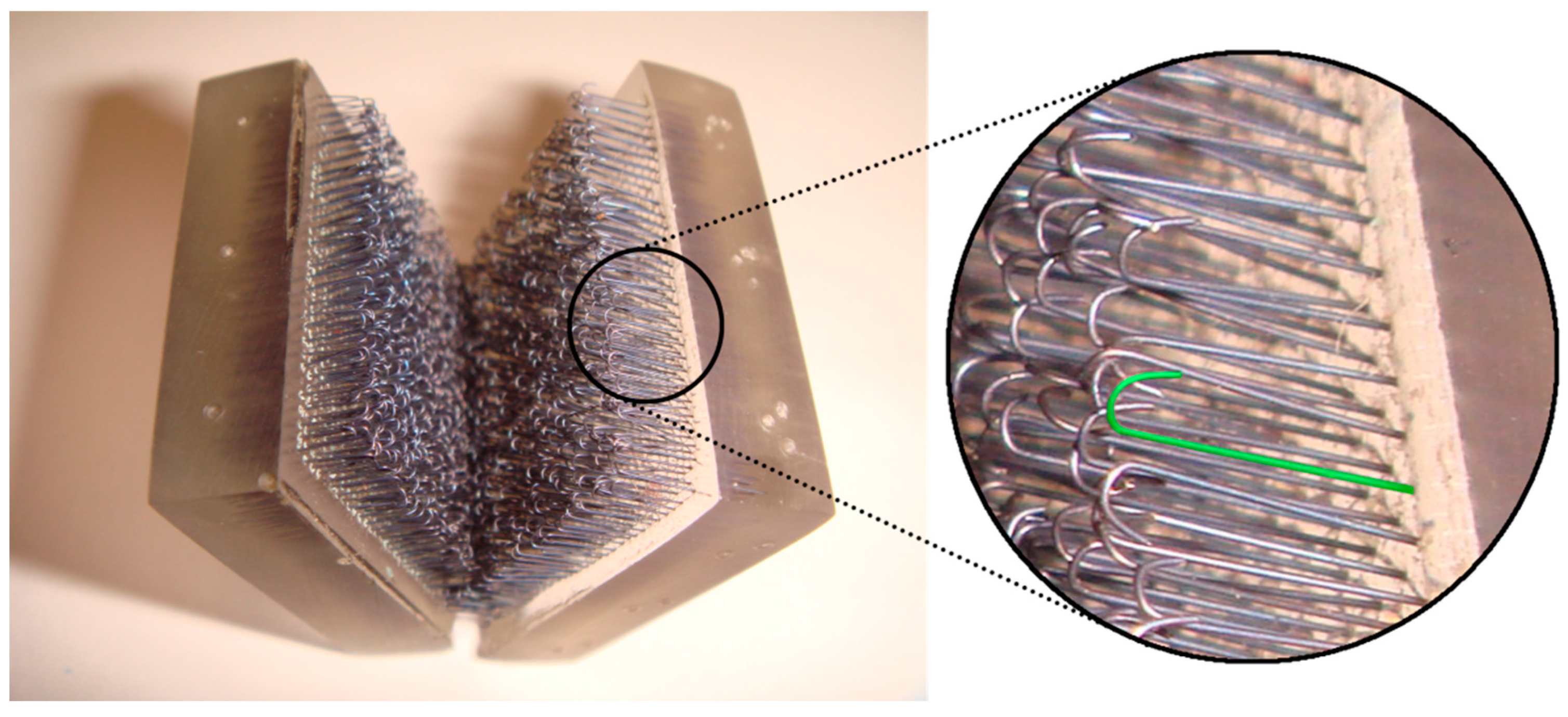
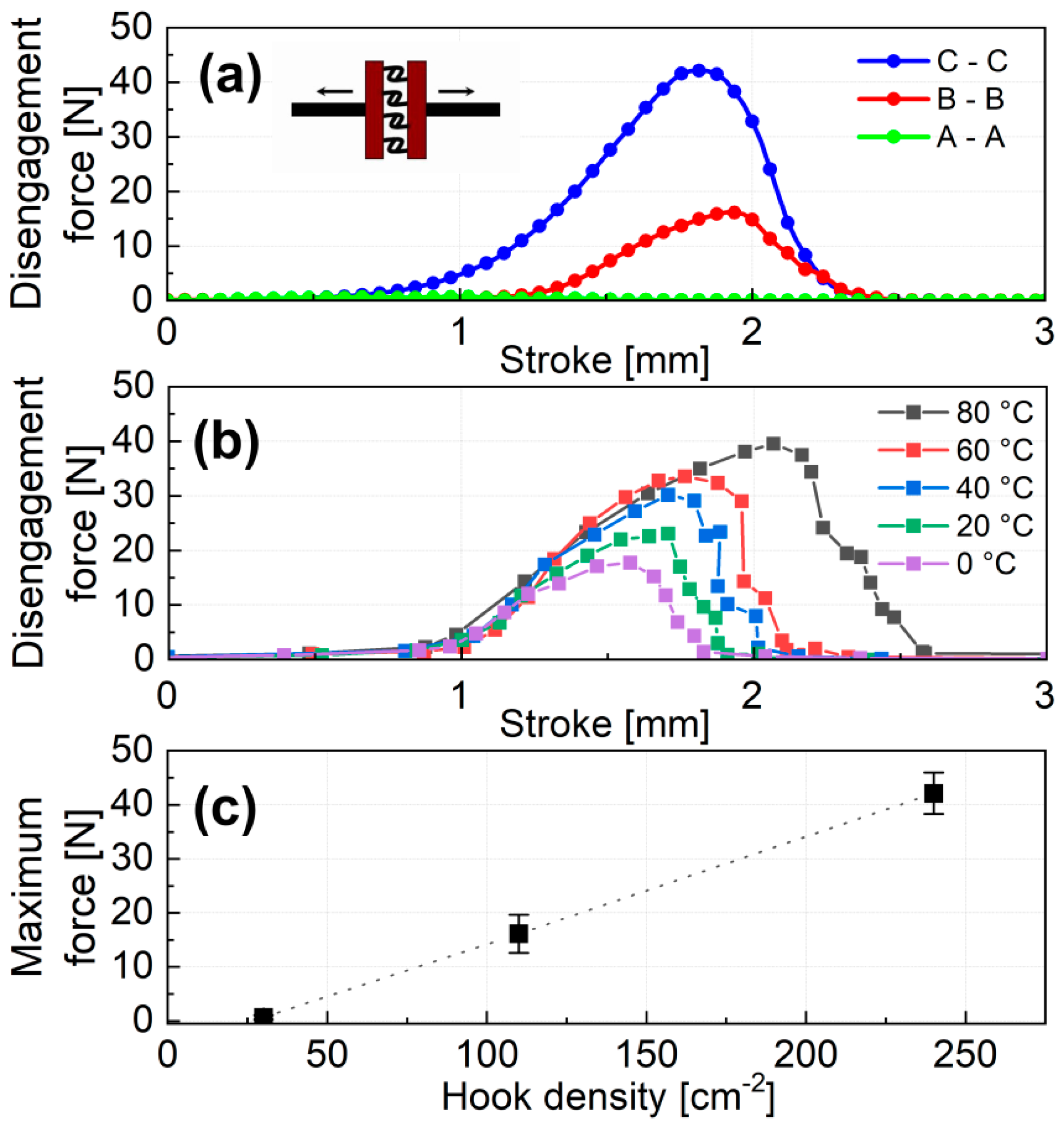
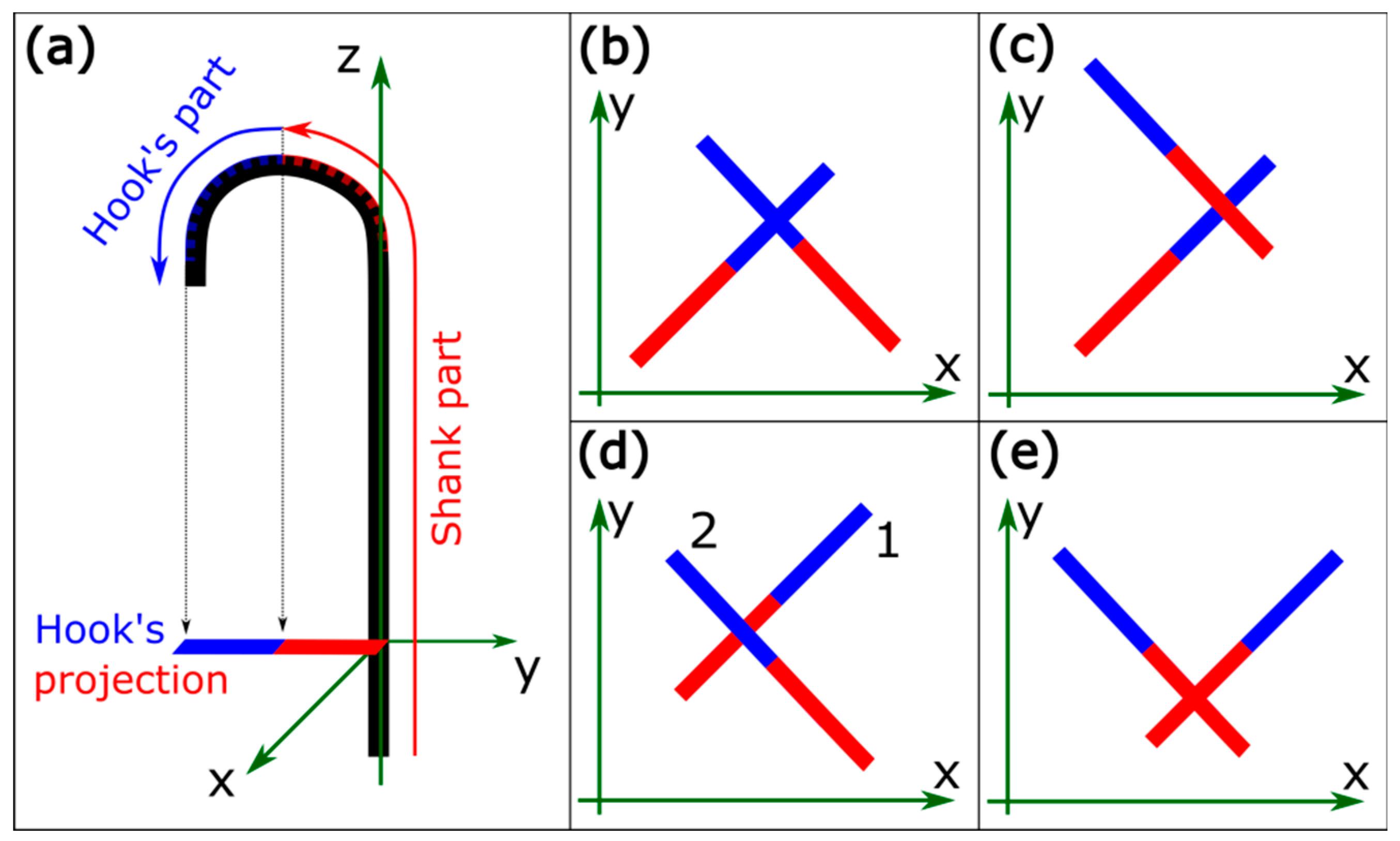
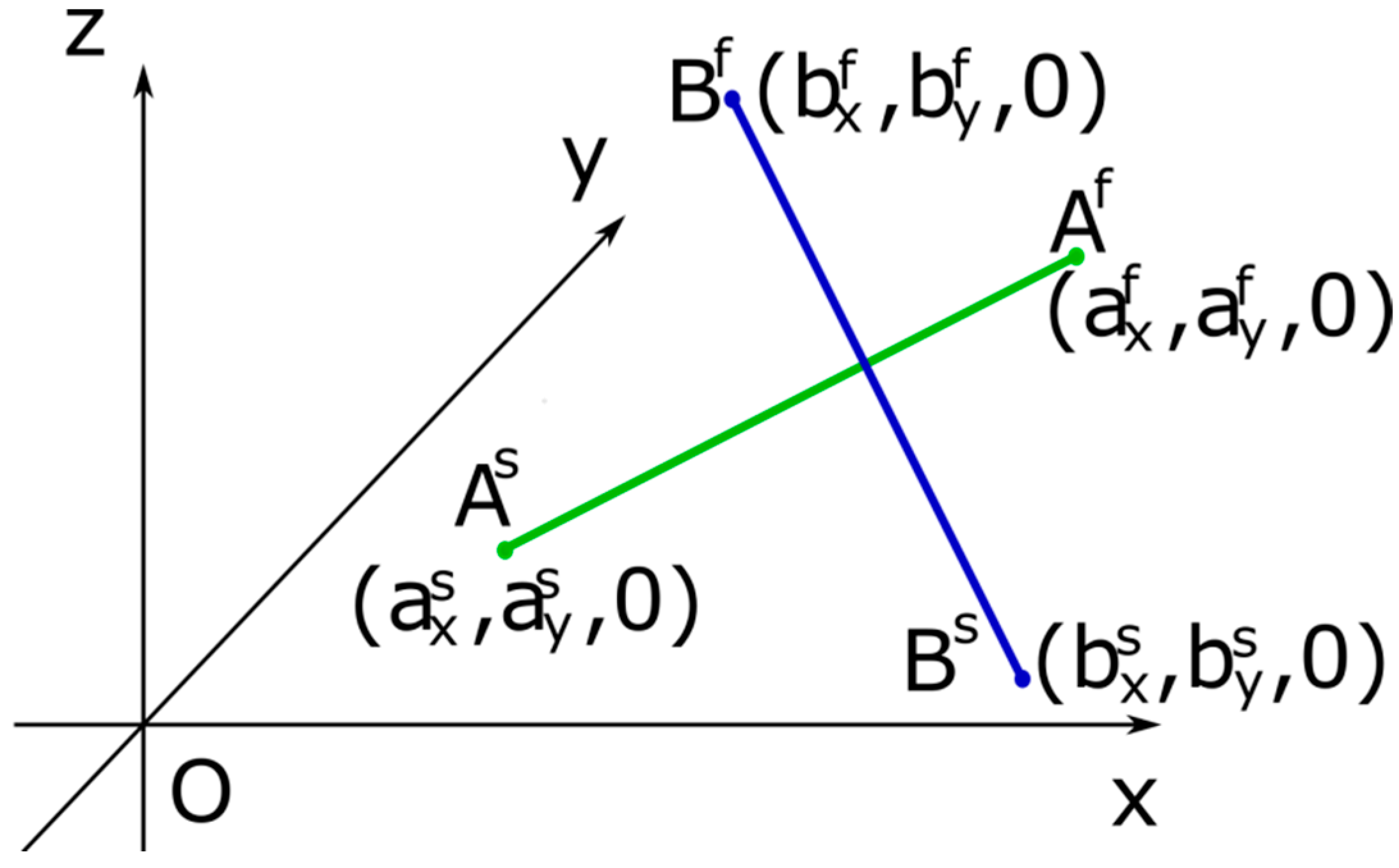
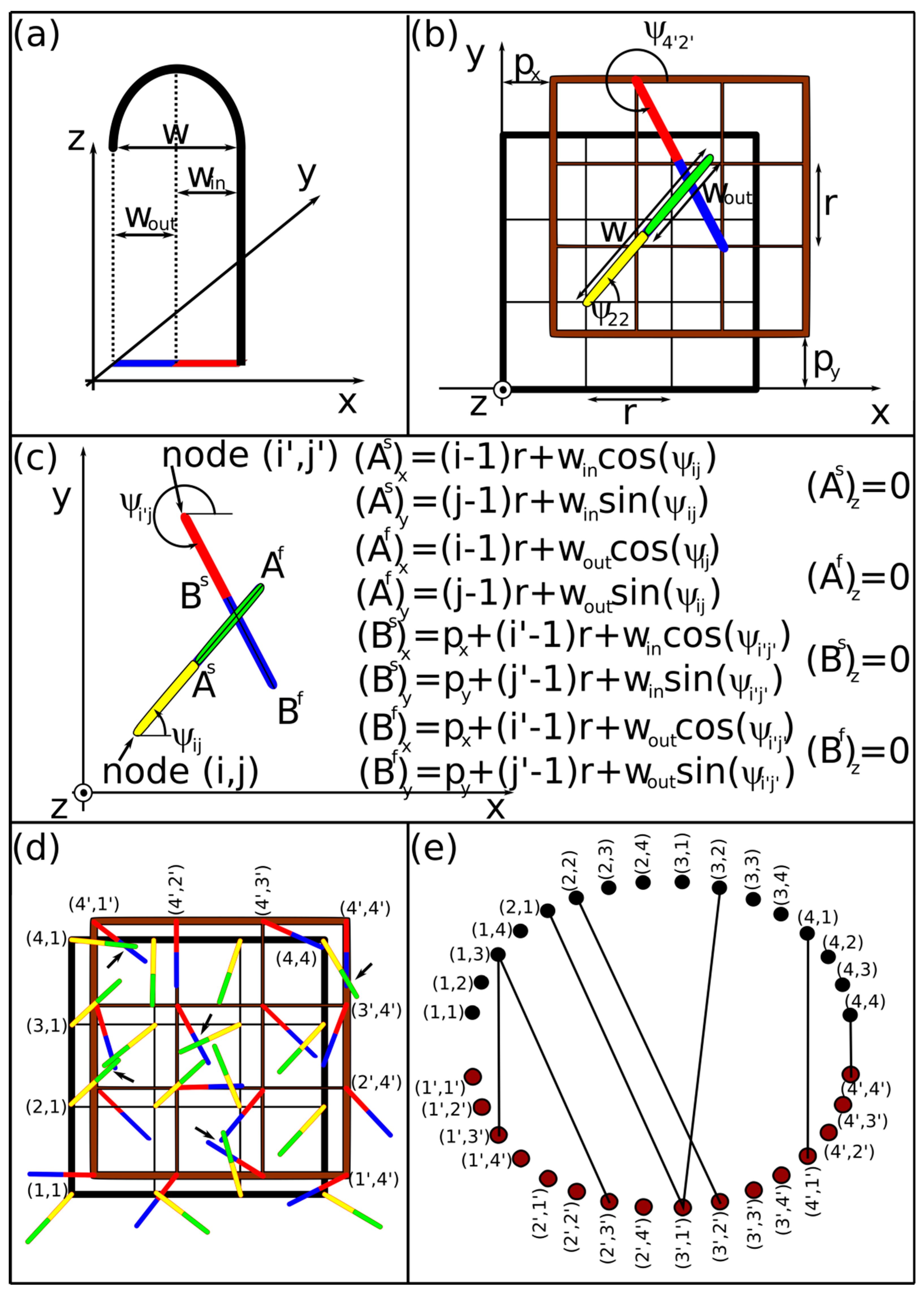

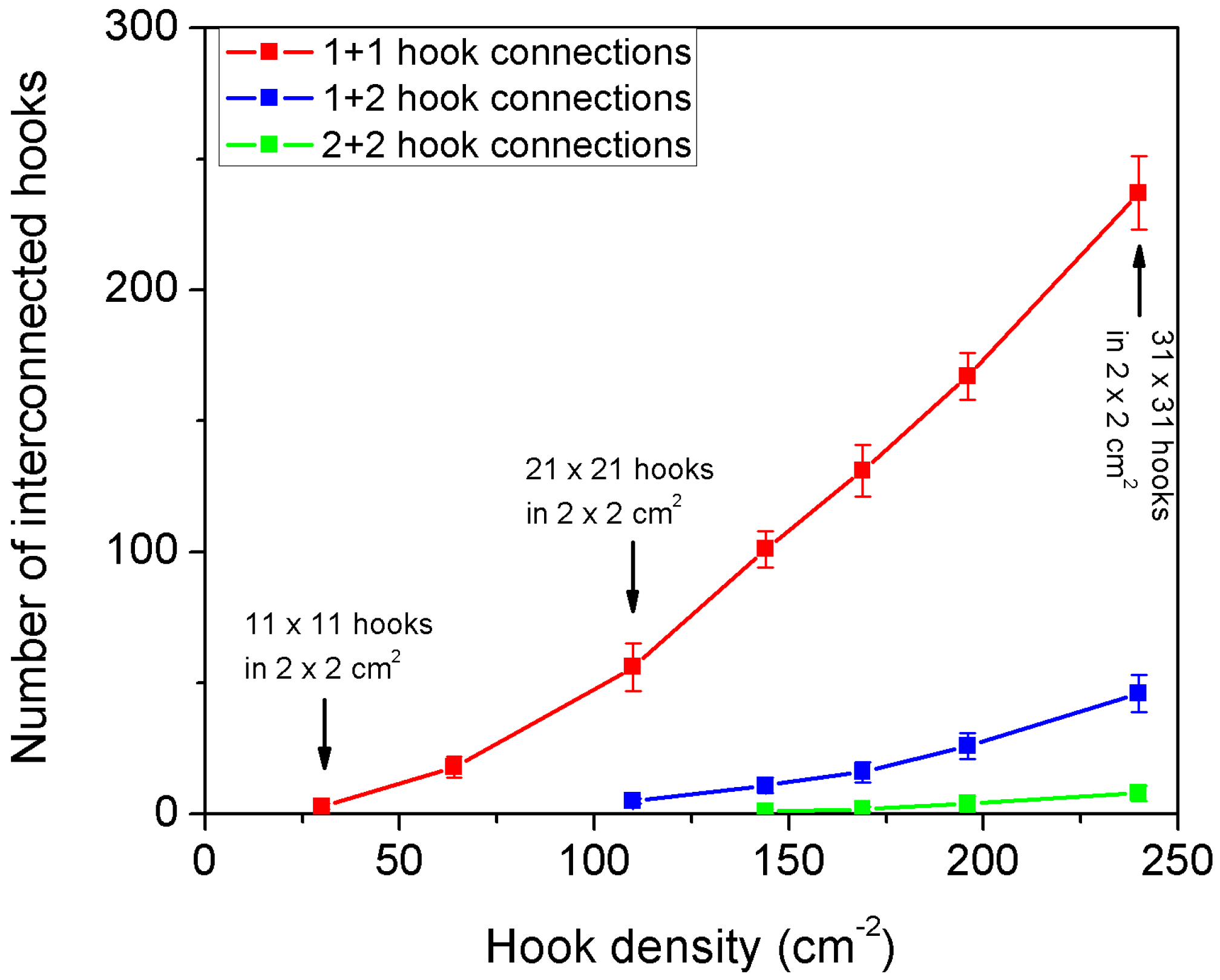
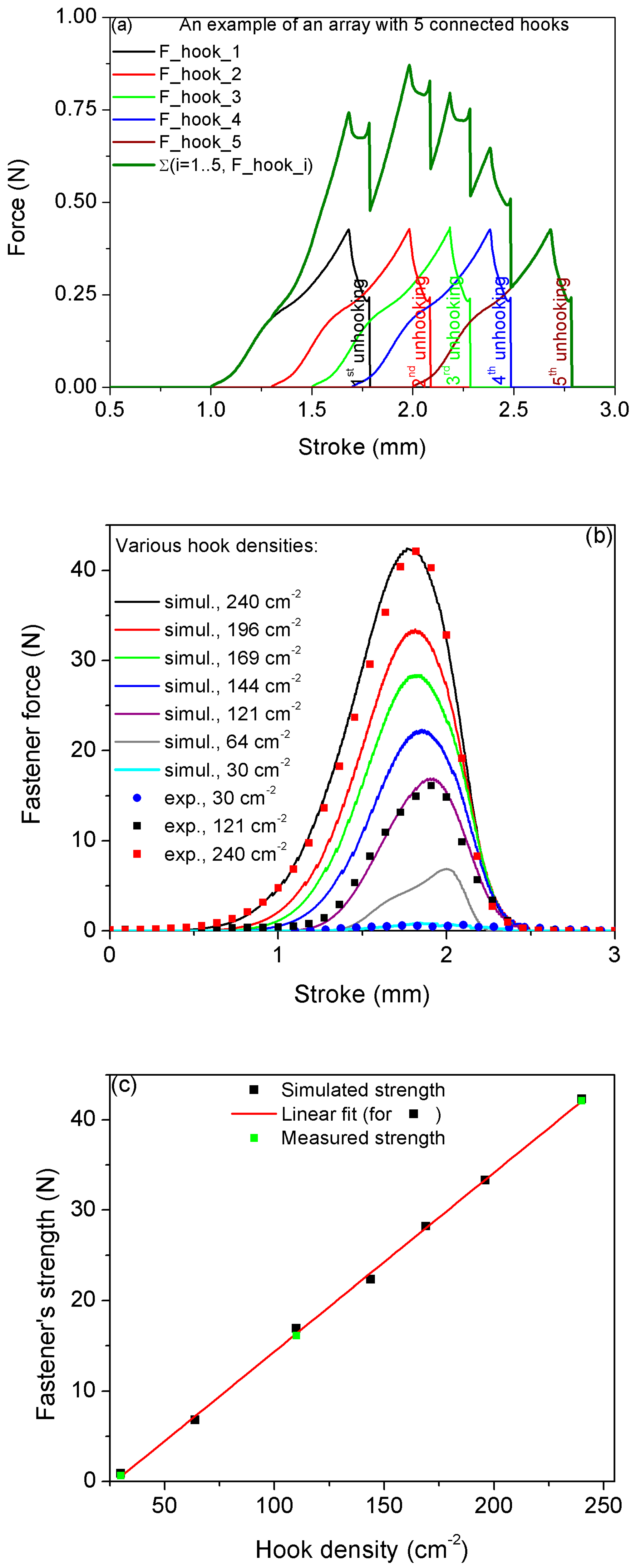
| Material Parameter’s Name/Unit | Material Parameter’s Value |
|---|---|
| Transformation yield stress of austenite at room temperature (MPa) | 553 |
| Maximum recoverable transformation strain in tension (%) | 5.2 |
| Ultimate tensile strength (MPa) | 1665 |
| Yield stress (MPa) | 1476 |
| Strain at failure (%) | 14.2 |
| Superelastic stress hysteresis (MPa) | 340 |
| Sample (A Single Array of Hooks) | NiTi Hook Density [hook/cm2] | Number of Hooks in Sample |
|---|---|---|
| A | 30 | 121 |
| B | 110 | 441 |
| C | 240 | 961 |
| Parameter’s Name/Unit | Value Used in the Model | Way of Obtaining the Value |
|---|---|---|
| Hook’s head width, w (mm) | 1 | Measured |
| win (mm), (Figure 6) | 0.5 | Measured |
| wout (mm), (Figure 6) | 0.5 | Measured |
| r (mm), (Figure 6) | 2; 1; 2/3 | Measured |
| Hook densities (cm−2) | 30; 110; 240 | Measured |
| Hook’s head orientation, ψij, ψi’j’. | Random, 0–2 π | Generated randomly in the Monte-Carlo model |
| Lateral shifts, px, py (mm), (Figure 6) | Random, (px)2 + (py)2 ≤ 1 | The limit value (1) was estimated to comply with the force-stroke measurements |
| Coefficients of Pa | Coefficients of Pa | Coefficients of Pb |
|---|---|---|
| a0 = 0.00208 | a5 = −2594.50272 | b0 = 2426.0141 |
| a1 = 0.37693 | a6 = 8558.6707 | b1 = −13,158.46915 |
| a2 = −3.10433 | a7 = −14,225.90391 | b2 = 26,774.58836 |
| a3 = 13.82738 | a8 = 11,915.33198 | b3 = −24,217.58423 |
| a4 = 302.65256 | a9 = −4012.15607 | b4 = 8214.6907 |
| Sample | Number of Hook Connections of Various Types at Hook Array Engagement as an Output of the Developed Method (Part 2.4) Mean ± SD | The Mean Equivalent Number of 1 + 1 Connections | ||
|---|---|---|---|---|
| 1 + 1 Connections | 1 + 2 Connections | 2 + 2 Connections | ||
| A-A | 3 ± 1 | 0 | 0 | 3 |
| B-B | 56 ± 9 | 5 ± 1 | 0 | 61 |
| C-C | 237 ± 14 | 46 ± 7 | 8 ± 3 | 299 |
Publisher’s Note: MDPI stays neutral with regard to jurisdictional claims in published maps and institutional affiliations. |
© 2021 by the authors. Licensee MDPI, Basel, Switzerland. This article is an open access article distributed under the terms and conditions of the Creative Commons Attribution (CC BY) license (https://creativecommons.org/licenses/by/4.0/).
Share and Cite
Vokoun, D.; Pilch, J.; Kadeřávek, L.; Šittner, P. Strength of Superelastic NiTi Velcro-Like Fasteners. Metals 2021, 11, 909. https://doi.org/10.3390/met11060909
Vokoun D, Pilch J, Kadeřávek L, Šittner P. Strength of Superelastic NiTi Velcro-Like Fasteners. Metals. 2021; 11(6):909. https://doi.org/10.3390/met11060909
Chicago/Turabian StyleVokoun, David, Jan Pilch, Lukáš Kadeřávek, and Petr Šittner. 2021. "Strength of Superelastic NiTi Velcro-Like Fasteners" Metals 11, no. 6: 909. https://doi.org/10.3390/met11060909
APA StyleVokoun, D., Pilch, J., Kadeřávek, L., & Šittner, P. (2021). Strength of Superelastic NiTi Velcro-Like Fasteners. Metals, 11(6), 909. https://doi.org/10.3390/met11060909






